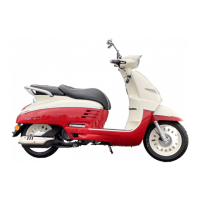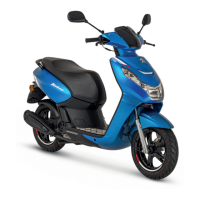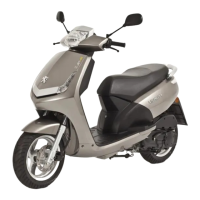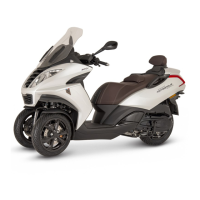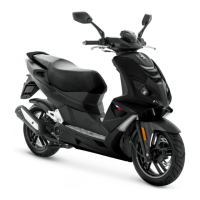Do you have a question about the PEUGEOT TWEET 50 2021 and is the answer not in the manual?
Welcome and overview of the Peugeot motorcycle user manual.
Essential safety advice for new riders, gear, and responsible vehicle use.
Detailed dimensions and weight specifications for Peugeot Tweet models.
Technical details on engine type, capacity, power, and fluid capacities.
Specifications for tyres, suspension components, and braking systems.
Information on headlights, bulbs, and the vehicle's battery.
Locating the VIN, manufacturer's plate, and engine number.
Guidance on appropriate fuels, engine oil, and other fluids.
Explanation of symbols used in the manual for warnings and important notes.
Diagram and list identifying key parts of the Peugeot Tweet.
Overview of the dashboard instruments for the 50cc model.
Overview of the dashboard instruments for the 125/200cc models.
Using the odometer, tripmeter, clock, and fuel gauge.
Explanation of horn, lights, indicator, and saddle release controls.
Understanding the ignition key positions and their functions.
Location and use of the circuit breaker and suspension damper adjusters.
Information on the utility hanger's placement and maximum load capacity.
Details on the lateral stand's ignition cut-out safety mechanism.
Essential checks to ensure vehicle safety and readiness before riding.
First-time use guidance, startup warnings, and eco-driving tips.
Risks and procedures for navigating flooded road conditions.
Detailed checks for fuel, oil, brakes, lights, tyres, and steering.
Step-by-step guide to safely start the vehicle's engine.
How to begin riding and control acceleration and deceleration.
Details on 50cc, 125cc (SBC), and 200cc (ABS) braking systems.
Guidelines for refueling and economical driving practices.
Recommended procedures for the engine's initial running-in phase (0-1000 km).
Proper methods for turning off the engine and parking the vehicle.
Importance of regular servicing and using authorized dealers.
Information on disposing of worn parts and the vehicle responsibly.
Safe methods for washing the vehicle, avoiding high-pressure cleaners.
Steps for checking electrode gap and replacing the spark plug.
How to accurately check the engine oil level using the dipstick.
Detailed steps for draining old engine oil and refilling with new.
Steps for draining and refilling the gearbox oil.
Instructions for removing, cleaning, and fitting a new air filter.
How to check and adjust the play in the throttle control cable.
Recommended tyre pressures and guidance on checking tread wear.
Methods for inspecting front and rear brake pad wear.
How to check the brake fluid level through the inspection window.
Safe practices for battery connection, charging, and potential hazards.
Advice for storing the vehicle long-term, focusing on battery maintenance.
Correct methods for charging the vehicle's battery safely.
How to access and identify the vehicle's fuses.
Table detailing fuse locations and ratings for different Tweet models.
Instructions for replacing headlights, indicators, and license plate bulbs.
Steps to adjust the vertical aim of the headlight beam.
Welcome and overview of the Peugeot motorcycle user manual.
Essential safety advice for new riders, gear, and responsible vehicle use.
Detailed dimensions and weight specifications for Peugeot Tweet models.
Technical details on engine type, capacity, power, and fluid capacities.
Specifications for tyres, suspension components, and braking systems.
Information on headlights, bulbs, and the vehicle's battery.
Locating the VIN, manufacturer's plate, and engine number.
Guidance on appropriate fuels, engine oil, and other fluids.
Explanation of symbols used in the manual for warnings and important notes.
Diagram and list identifying key parts of the Peugeot Tweet.
Overview of the dashboard instruments for the 50cc model.
Overview of the dashboard instruments for the 125/200cc models.
Using the odometer, tripmeter, clock, and fuel gauge.
Explanation of horn, lights, indicator, and saddle release controls.
Understanding the ignition key positions and their functions.
Location and use of the circuit breaker and suspension damper adjusters.
Information on the utility hanger's placement and maximum load capacity.
Details on the lateral stand's ignition cut-out safety mechanism.
Essential checks to ensure vehicle safety and readiness before riding.
First-time use guidance, startup warnings, and eco-driving tips.
Risks and procedures for navigating flooded road conditions.
Detailed checks for fuel, oil, brakes, lights, tyres, and steering.
Step-by-step guide to safely start the vehicle's engine.
How to begin riding and control acceleration and deceleration.
Details on 50cc, 125cc (SBC), and 200cc (ABS) braking systems.
Guidelines for refueling and economical driving practices.
Recommended procedures for the engine's initial running-in phase (0-1000 km).
Proper methods for turning off the engine and parking the vehicle.
Importance of regular servicing and using authorized dealers.
Information on disposing of worn parts and the vehicle responsibly.
Safe methods for washing the vehicle, avoiding high-pressure cleaners.
Steps for checking electrode gap and replacing the spark plug.
How to accurately check the engine oil level using the dipstick.
Detailed steps for draining old engine oil and refilling with new.
Steps for draining and refilling the gearbox oil.
Instructions for removing, cleaning, and fitting a new air filter.
How to check and adjust the play in the throttle control cable.
Recommended tyre pressures and guidance on checking tread wear.
Methods for inspecting front and rear brake pad wear.
How to check the brake fluid level through the inspection window.
Safe practices for battery connection, charging, and potential hazards.
Advice for storing the vehicle long-term, focusing on battery maintenance.
Correct methods for charging the vehicle's battery safely.
How to access and identify the vehicle's fuses.
Table detailing fuse locations and ratings for different Tweet models.
Instructions for replacing headlights, indicators, and license plate bulbs.
Steps to adjust the vertical aim of the headlight beam.
| Brand | PEUGEOT |
|---|---|
| Model | TWEET 50 2021 |
| Category | Motorcycle |
| Language | English |


